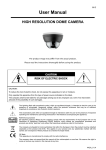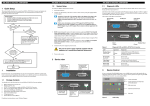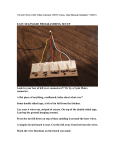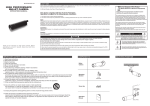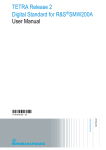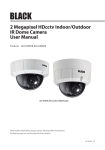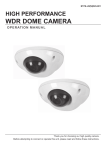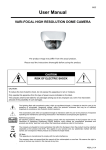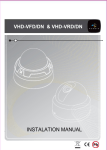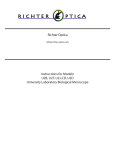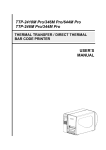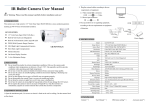Download OSD menu On Screen Display - Legrand E
Transcript
EFFIO E and P OSD menu OSD menu On Screen Display LE05648AA USER MANUAL Contents 1 Using the OSD................................................................................................................ 3 1.1 Controlling the OSD MENU .......................................................................................................... 3 1.2 Sony EFFIO E description ............................................................................................................ 4 1.3 Sony EFFIO P description ............................................................................................................ 5 2 Functions ........................................................................................................................ 6 2.1 2.1.1 Brightness management: according to indoor, outdoor or night environment ................ 6 Image adjustment:............................................................................................................................................................................................ 6 2.1.2 Assistance with displaying dark or night-time images: AGC (Auto Gain Control),Shutter, NR (Noise Reduction), HLC (High Light Compensation) ...................................................................................................................................................... 6 2.1.3 Backlight management: ATR (Adaptive Tone Reproduction), BLC (Back Light Compensation), WDR (Wide Dynamic Range), WB (White Balance) and DSS (Digital Slow Shutter) ................................................................................................ 7 2.2 Other main functions ..................................................................................................................... 8 3 Main differences between EFFIO E and EFFIO P .................................................... 8 2 1 Using the OSD The EFFIO P and Enhanced EFFIO E cameras equipped with DSP (Digital Signal Processing) include OSD (On Screen Display) functions for adjusting the camera via menus displayed on the screen. 1.1 Controlling the OSD MENU The OSD menu can be controlled using a joystick or several buttons, depending on the type of camera (dome, modular or outdoor camera). Joystick or buttons for controlling theOSD menu RCA connector. Use the RCA-BNC cable provided to display the analogue output Pressthecentralbuttonor the joysticktoaccessthecamera'sconfiguration(OSD) menu. Themainconfigurationmenuappearsonthe screen: Select a function using the directions of the joystick or the up and down buttons. Modify the value of a parameter using the joystick or the left and right buttons. If a submenu is available, it can be accessed by pressing the central button or the joystick. General settings Actions Indicates that there is a submenu. The value of the setting preceding this symbol can be modified. NEXT/BACK Displays the rest of the main menu or returns to the previous menu. EXIT Closes the menu and retains the modifications as long as the camera remains switched on. SAVE ALL Saves the settings and retains them after the camera is switched off. 3 1.2 Sony EFFIO E description 4 1.3 Sony EFFIO P description 5 2 Functions When a camera is installed it is important to adjust the settings according to the usual operating conditions (indoor, outdoor and/or night). Combining several settings will lead to an improvement. Not all camera models have the same menus, and the possibilities for their adjustment are more or less sophisticated. The more complex models (EFFIO P) enable better management of difficult brightness conditions such as backlight. Here we are talking about typical settings that have an impact on the image quality. They are dealt with and grouped together according to the surrounding conditions. 2.1 Brightness management: according to indoor, outdoor or night environment 2.1.1 - Image adjustment: PICT ADJUST (Brightness, Contrast, Sharpness, Hue, Gain) o - DIS (Digital Image Stabilization) and Ezoom (Electronic zoom) are functions only available on EFFIO P. SHUTTER/AGC for EFFIO E or the EXPOSURE menu for EFFIO P combine: o SHUTTER: shutter speed o IRIS: lens diaphragm aperture The shutter and iris settings define the amount of light reaching the sensor in a given period of time. - o GAIN: amplification of the signal WHITE BALANCE: is used to calibrate the sensor and correct the predominance of one colour according to the ambient lighting. Each type of light has a specific predominant colour: orange-tinged for indoor lights (tungsten), bluish for daylight, whitish under an overcast sky or greenish under neon lights. This is referred to as colour temperature. The human eye is not fooled by differences in colour temperature; however a camera has to be "calibrated" so that the colorimetry of the video is correct. The white balance can be set manually using MANUAL WB, or automatic settings such as the following can be used: o ATW (Auto Tracking White Balance): the camera automatically adjusts the white balance according to changes in the light. The ATW FRAME setting sets the adjustment frequency. Additional controls in this menu (SPEED, DELAY CONT and ATW FRAME) can be used in environments with lighting combinations such as fluorescent tubes, sunlight or incandescent light. 2.1.2 o ANTI-CR (Anti Color Rolling): When installed in an area lit by a fluorescent light source, the camera may be affected by the flickering frequency of this light source, which leads to the white balance changing the colours cyclically. This effect is called Color Rolling. Anti CR is a function which eliminates this unwanted effect. o INDOOR, OUTDOOR: On all cameras, the white balance mode can be preset according to a predefined environment. Assistance with displaying dark or night-time images: AGC (Auto Gain Control),Shutter, NR (Noise Reduction), HLC (High Light Compensation) The electronic circuit measures the light level captured by the camera in real time. If the light is below the colour mode operating limit, the CCTV camera automatically switches to black and white mode.The minimum required light level is only 0.1 lux for colour and 0.01 lux for black and white. - AGC (Auto Gain Control): measures the level of the video signal in real time then amplifies it if the signal is too low (image too dark). This function enables images to be brightened automatically when the CCTV camera is placed in an environment where the lighting level is inadequate. Gain that is too high generates noise in the image. EXPOSURE/MANUAL SETUP menu for EFFIO P and SHUTTER/AGC/MANUAL SETUP menu for EFFIO E. - DAY/NIGHT: determines the levels for day/night and night/day switching in AUTO mode, and sets the camera to black and white or colour 6 - SHUTTER, SLOW SHUTTER or DSS (Digital Slow Shutter): reduces the exposure speed, thus increasing the sensitivity of the camera. EXPOSURE/MANUAL SETUP menu for EFFIO P and SHUTTER/AGC/MANUAL SETUP menu for EFFIO E. - NR (Noise Reduction) or DNR (Digital Noise Reduction): uses a digital process to reduce the noise in the image.Image noise causes the graininess that we see when the CCTV camera is used in a very dark environment. 2D DNR reduces this fault to improve the imagequality.It is available on both EFFIO E and EFFIO P cameras. EFFIO P cameras also have the 3D-NR setting, which improves the colour reproduction. 2D-NR: 2D+3D-NR - HLC (High Light Compensation): compensation for high light levels. This identifies and compensates areas exposed to a strong light from a source located facing the camera.It darkens the areas exposed to strong light in order to improve the display of details in the under-exposed areas. 2.1.3 Backlight management: ATR (Adaptive Tone Reproduction), BLC (Back Light Compensation), WDR (Wide Dynamic Range), WB (White Balance) and DSS (Digital Slow Shutter) - ATR (Adaptive Tone Reproduction): improves the ability to reproduce details when the image contains very bright areas and very dark areas.In the example below, the overexposed area and the underexposed area are corrected automatically by the ATR function. - BLC (BackLight Compensation): automatic backlight compensation.Works by selecting the area of the image which must be subject to automatic lens control. This enables the required areas to be reproduced with the right exposure. If there is backlight, the camera adjusts the lens according to the selected area and ignores the high light level of the background. The BLC function is extremely effective, however it is important to remember that the bright area of the scene may be overexposed. This function is only available on EFFIO E cameras. - WDR (Wide Dynamic Range): enables a camera to filter out intense background light, thus improving the ability to distinguish the features and shapes of a subject placed in shadow. This function is only available on EFFIO P cameras with DSP. 7 2.2 Other main functions Masking is the function for masking private areas or areas where filming is prohibited. Masked areas are covered by black squares on the image. Camera Reset: this function resets the camera to the original settings. It is in the OTHER menu on EFFIO P cameras and at the bottom of the main menu on EFFIO E cameras. 3 Main differences between EFFIO E and EFFIO P Main functions EFFIO-P Enhanced EFFIO-E Horizontal resolution 700 TVL 500 to 700 TVL (depending on the model) Wide dynamic range Yes No ATR ATR-EX ATR Noise reduction 2D & 3D-NR 2D-NR Day & Night IR exposure control Yes Yes Privacy mask 20 masks 8 masks E-zoom Yes No Slow shutter (Sens-up) Yes No Digital Image Stabilizer Yes No HLC Yes Yes Motion detection Yes Yes 8









